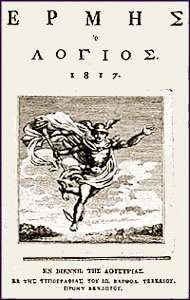Theodore Kavalliotis
| Theodore Kavalliotis | |
|---|---|
| Born |
1718 Kavala |
| Died |
1789 Moscopole |
| Nationality | Aromanian ancestry, Greek identity |
| Occupation |
Schoolmaster at the New Academy (Moscopole), Philosopher, Priest |
| Religion | Eastern Orthodox |
Theodore Kavalliotis (Greek: Θεόδωρος Αναστασίου Καβαλλιώτης, Romanian: Teodor Kavalioti, 1718 – 11 August 1789[1]) was a Greek Orthodox priest, teacher and a figure of the Greek Enlightenment.[2] He is also known for having drafted an Aromanian-Greek-Albanian dictionary.[3]
Early life
Kavalliotis was born in the then important Ottoman town of Moscopole (now a tiny village, Voskopojë, in southeast Albania), where he also spent most of his life. He was of Aromanian ancestry[4] and with Greek identity.[5] Kavalliotis studied in Moscopole and later pursued higher studies in mathematical and philosophical sciences at the Maroutseios college in Ioannina (in 1732-1734), directed by Eugenios Voulgaris.[6]
Working period
He returned to Moscopole and was appointed teacher at the New Academy (Greek: Νέα Ακαδημία Nea Akadimia) in 1743.[7] In 1750 he succeeded his former teacher Sevastos Leontiadis and became director of the New Academy for more than 20 years (1748–1769).[8] His works, written in Greek, are Logic (1749, unpublished), Physics (1752, unpublished), Grammar of modern Greek (1760), Metaphysics (1767), Protopeiria (1770). They were used extensively and hand-made copies were found even as far as Iaşi, Romania. After the destruction of Moscopole at 1769, he probably went to Tokaj, Hungary, but returned at 1773.[8]
In 1770, he published in Venice, at Antonio Bortoli's printing press, a school textbook, called Protopeiria.[9] Protopeiria is a 104 pages textbook which in pages 15–59 included a trilingual lexicon of 1,170 Greek, Aromanian, and Albanian words.[10] This work aimed at the Hellenization of the non-Greek-speaking Christian communities in the Balkans.[11][12] The lexicon was re-published in 1774 by the Swedish[13] professor Johann Thunmann, who taught at the University of Halle-Wittenberg. Thunmann added a Latin translation to the words in Greek, Aromanian, and Albanian.[14]
Besides Eugenios Voulgaris, he was also influenced by the work of Vikentios Damodos, Methodios Anthrakites, René Descartes, and medieval scholastics.
Kavalliotis couldn't manage to reestablish the destroyed New Academy.[15] During his last months he witnessed another wave of destruction of his home place, in June 1789 by local Muslim lords. Kavalliotis died at August 11, 1789, aged 71.[16]
Sample from the first page of the Lexicon
| Ῥωμαίϊκα (Romaic - modern Greek) | Βλάχικα (Vlach - Aromanian) | Ἀλβανίτικα (Albanian) | English translation |
|---|---|---|---|
| Ἀββᾶς | Ηγούμενου (Igumenu) | Ηγκουμέν (Igumen) | Abbot |
| Ἀγαλια | Ανάργα (Anarga) | Γκαντάλε (Ngadalë) | Slowly |
| Ἀγαπῶ | Βόη (Voe) | Ντούα (Dua) | (I) Love |
| Ἄγγελος | Άγγελου (Aghelu) | Έγγελ (Engjëll) | Angel |
| Ἀγγεῖον | Βάσου (Vasu) | Ένᾳ (Enë) | Pot |
| Ἀγγίσρι | Γκρέπου (Grepu) | Γκρέπ (Grep) | Fish hook |
| Ἀγελάδα | Βάκᾳ (Vaca) | Λιόπᾳ (Lopë) | Cow |
| Ἅγιος | Σᾴμτου (Santu) | Σσιέντ (Shenjt) | Saint |
| Ἀγκάθι | Σκίνου (Schinu) | Γκιέπ (Gjemb) | Thorn |
| Ἀγκάλη | Μπράτζᾳ (Mbrata) | Πουσστίμ (Pushtim) | Embrace |
| Ἀγκοῦρι | Καϛραβέτζου (Castravetu) | Κραϛαβέτζ (Kastravec) | Cucumber |
| Ἀγκῶνας | Κότου (Cotu) | Μπᾳλλίουλ (Bërryl) | Elbow |
| Ἀγνάντια | Καρσσί (Carsi) | Κουντρέ (Kundër) | Opposite |
Works
- Εἰσαγωγὴ εἰς τὰ ὀκτω μέρη τοῦ λόγου. Ἐν Μοσχοπόλει 1760 καὶ Ἑνετίῃσι 1774.
- Ἔπη πρὸς τὸν ἐξαρχικῶν ἐν Μοσχοπόλει ἐπιδημήσαντα Ἰωαννίκιον Χαλκηδόνος ἐν ἔτει 1750 Μαΐου 2.
- Πρωτοπειρία. (Starting out) Ἑνετίῃσιν, 1770. Παρὰ Ἀντωνίῳ τῷ Βόρτολι. Superiorum permissu. Ac privilegio.
References
- ↑ The Codex of Saint John Prodromos' monastery, Moschopolis: 1789, Αὐγούστου 11 ἡμέρα ϐ ἐπλέρωσεν τὸ κοινὸν ὁ ἱεροδιδάσκαλος Πρωτοπαπᾶς Θεόδωρος Ἀναστασίου Καβαλλιώτης - Αἰωνία τοῦ ἡ μνήμη. (p. 29.)
- ↑ Asterios I. Koukoudēs. The Vlachs: Metropolis and Diaspora. Zitros, 2003, ISBN 978-960-7760-86-9, p. 335.
- ↑ Lloshi p.275
- ↑ Lloshi, Xhevat (2008). Rreth Alfabetit te shqipes. Logos. pp. 273–276. ISBN 9989582688. Retrieved 2010-06-01.
- ↑ Kahl Thede, Γλώσσα και στόχοι του πρώιμου αρμανικού, γραπτού λόγου (1731-1813), p. 71 (German original: Sprache und Intention der ersten aromunischen Textdokumente, 1731-1809) in Για την ταυτότητα των Βλάχων: εθνοπολιτισμικές προσεγγίσεις μιας βαλκανικής πραγματικότητας, Βιβλιόραμα (2009)
- ↑ Dieter Kremer: Actes du XVIIIe Congrès International de Linguistique et de Philologie Romanes; 1989. p. 122
- ↑ Tassos A. Mikropoulos. Elevating and Safeguarding Culture Using Tools of the Information Society: Dusty traces of the Muslim culture. Earthlab. ISBN 978-960-233-187-3, p. 316.
- 1 2 Κεκρίδης (1988), p. 283
- ↑ Greece and the Balkans: identities, perceptions and cultural encounters since the Enlightenment; ed. by Tziovas, Dimitris.
- ↑ Lloshi p. 282
- ↑ Friedman A. Victor. After 170 years of Balkan linguistics. Wither the Millennium? University of Chicago. p. 2: "...given the intent of these comparative lexicons was the Hellenization of non-Greek-speaking Balkan Christians...
- ↑ Horst Förster, Horst Fassel. Kulturdialog und akzeptierte Vielfalt?: Rumänien und rumänische Sprachgebiete nach 1918. Franz Steiner Verlag, 1999. ISBN 978-3-7995-2508-4. p. 35, 45.
- ↑ "Johann Thunmann: On the History and Language of the Albanians and Vlachs". R. Elsie.
- ↑ Lloshi pp. 290-292 and p.317
- ↑ Kekridis (1989): p. 66
- ↑ Kekridis (1989): p. 68
Sources
- Hetzer, Armin; Roman, Viorel S. (February 1983), Albania, Walter De Gruyter Inc, ISBN 978-3-598-21133-1
- Κεκριδής Ευστάθιος (1989), "Θεόδωρος Αναστασίου Καβαλλιώτης (1718; 1789). Ο Διδάσκαλος του Γένους", Aristotle University of Thessaloniki, retrieved 2010-09-11
- Lloshi, Xhevat (2008), Rreth Alfabetit te Shqipes, Logos

